Home •This week’s blog • Time for tea • Blackbirds • Border collies
To make the pages download more quickly, we are slowly moving the main species at Durrell to their own dedicated pages. The articles will still be indexed at the main Durrell's Creatures page
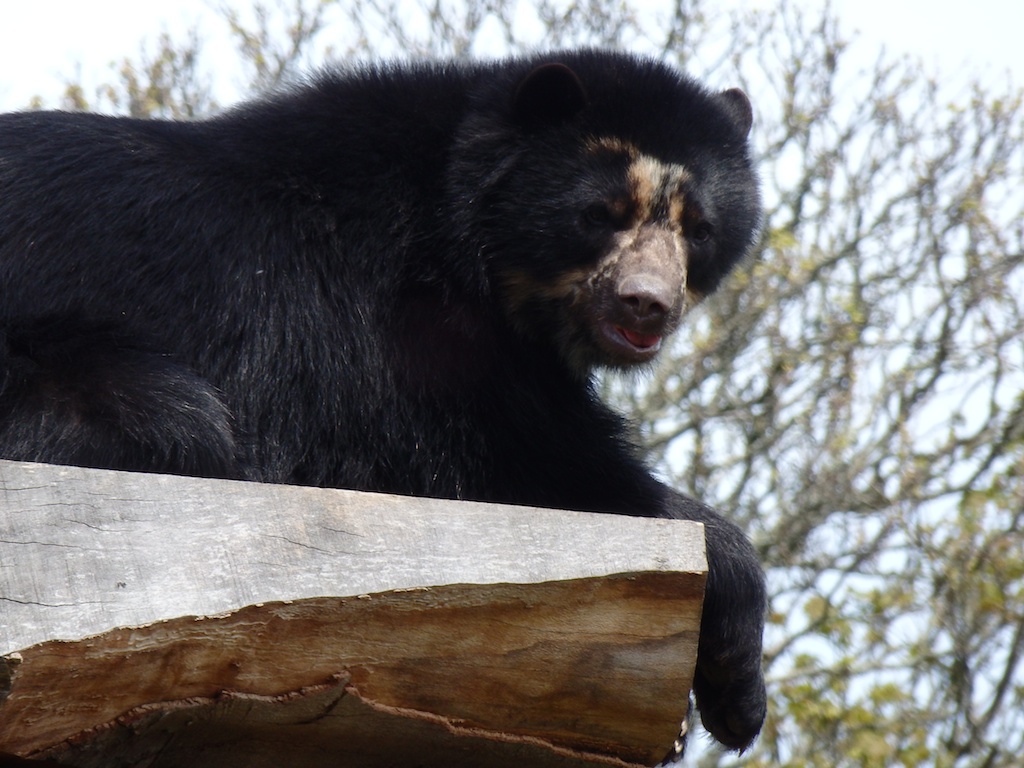 1 Exploring new quarters
1 Exploring new quarters
The sound of water filled the air as soon as I walked through the entrance into Durrell. It glittered as it spilled down the high fall to flow gently in streams down to the moat that curved around the island. The glade in this half of the island was green with thick grass, and the opening leaves of the oaks would soon create a canopy over what seems to be a graveyard of dead trees. Great stumps stick out like giant warts, here and there connected by curved half trunks to make wooden bridges. Other bare trunks rear their arms high, without any leaves to garnish them, but sometimes ending in large platforms. Y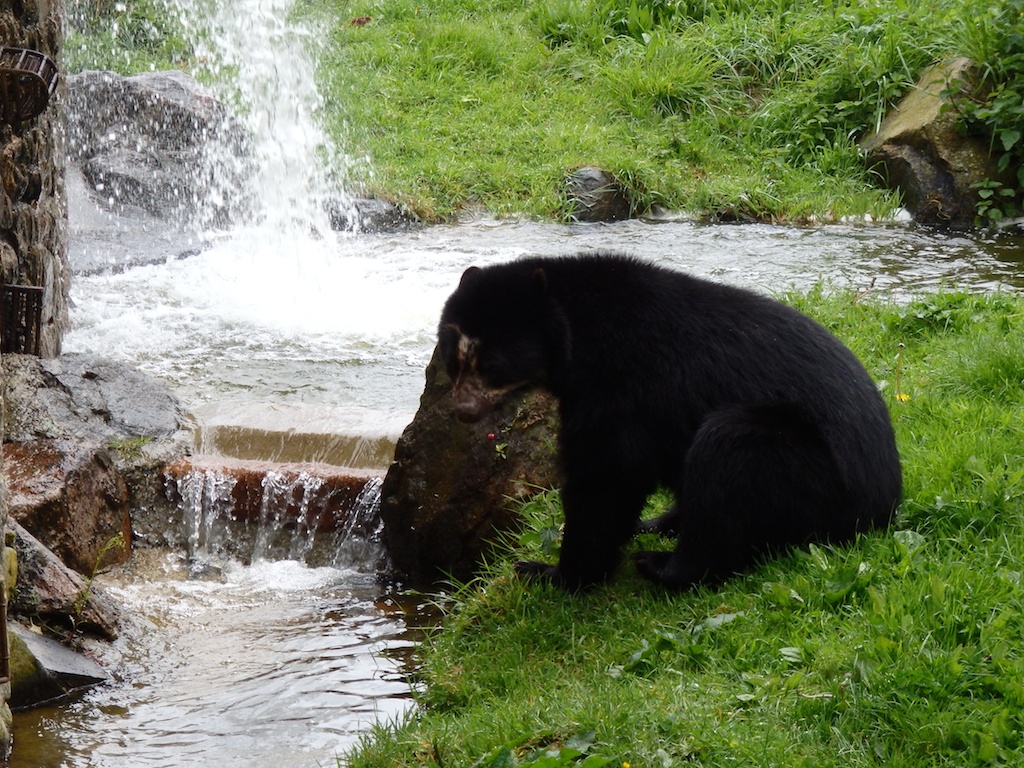 et more trunks lie at awkward angles, linking the network loosely together in a huge tangled web.
et more trunks lie at awkward angles, linking the network loosely together in a huge tangled web.
Seagulls perch individually on the trees, or in a row on the wooden bridges, and a robin moves confidently through the grass. But this is the home and playground, feeding place and basking spot for Bahia and Quechua, the two Andean bears, who have recently moved into the newly refurbished accommodation.
The indoor bear quarters, in the building that divides the island in half, have also been refitted. There is the inevitable increase in trunks for these young creatures to climb over and gnaw, the bark-less lengths carefully circled with rope to improve the bears’ purchase as they go up and down. But there is also the massive red rubber ball hanging conspicuously from the ceiling, which Quechua, pushes idly from time to time, making it bounce satisfyingly off the nearest wall.
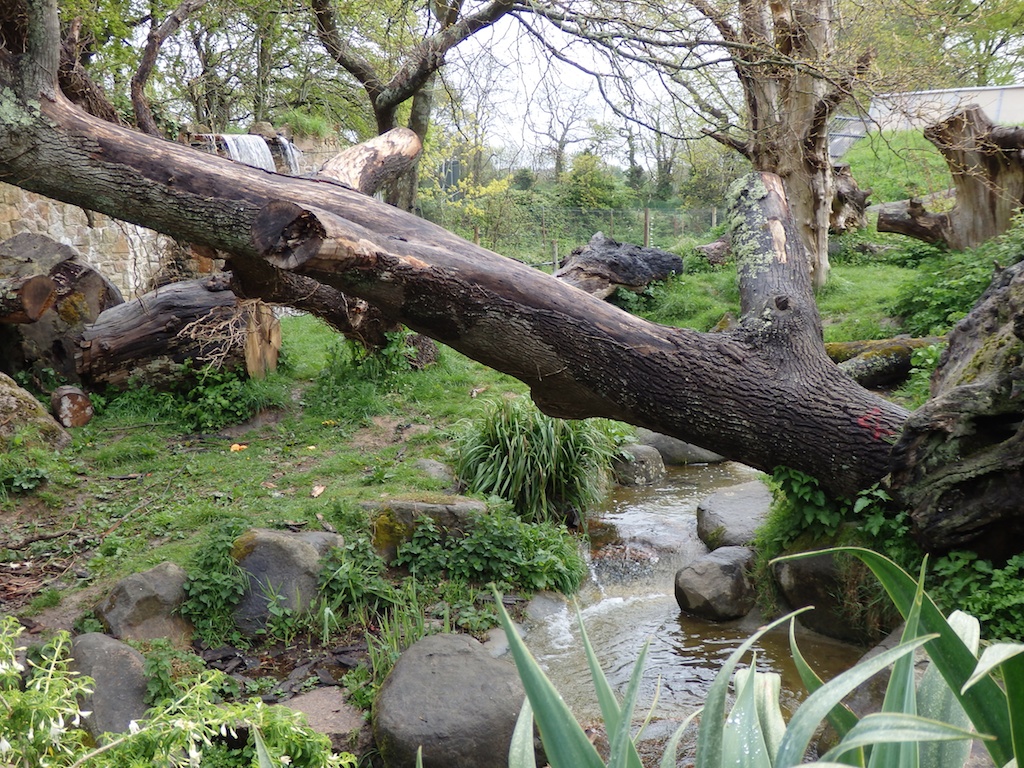 And there is the litter of logs, clustered near the viewing window, and tidied into a neat heap after the den has been cleaned. Bahia and Quechua investigated the new neat pile, effortless heaving large pieces around, thoughtfully gnawing others, and walking nonchalantly over the unsteady mound to move on to something more immediately interesting. For if they’re not resting they’re eating or playing, naturally much more active than their predecessors Barbara and Wolfgang who had subsided into a slower pace as they aged. It was a great pleasure to watch their elderly routine, which swung between Barbara’s fractious irritation at Wolfgang’s constant pestering, and their joint desire to be together, cuddling up on the floor with each other in their last years. Now it’s as great a pleasure to watch these new bears finding their way around their new environment and learning to live together.
And there is the litter of logs, clustered near the viewing window, and tidied into a neat heap after the den has been cleaned. Bahia and Quechua investigated the new neat pile, effortless heaving large pieces around, thoughtfully gnawing others, and walking nonchalantly over the unsteady mound to move on to something more immediately interesting. For if they’re not resting they’re eating or playing, naturally much more active than their predecessors Barbara and Wolfgang who had subsided into a slower pace as they aged. It was a great pleasure to watch their elderly routine, which swung between Barbara’s fractious irritation at Wolfgang’s constant pestering, and their joint desire to be together, cuddling up on the floor with each other in their last years. Now it’s as great a pleasure to watch these new bears finding their way around their new environment and learning to live together.
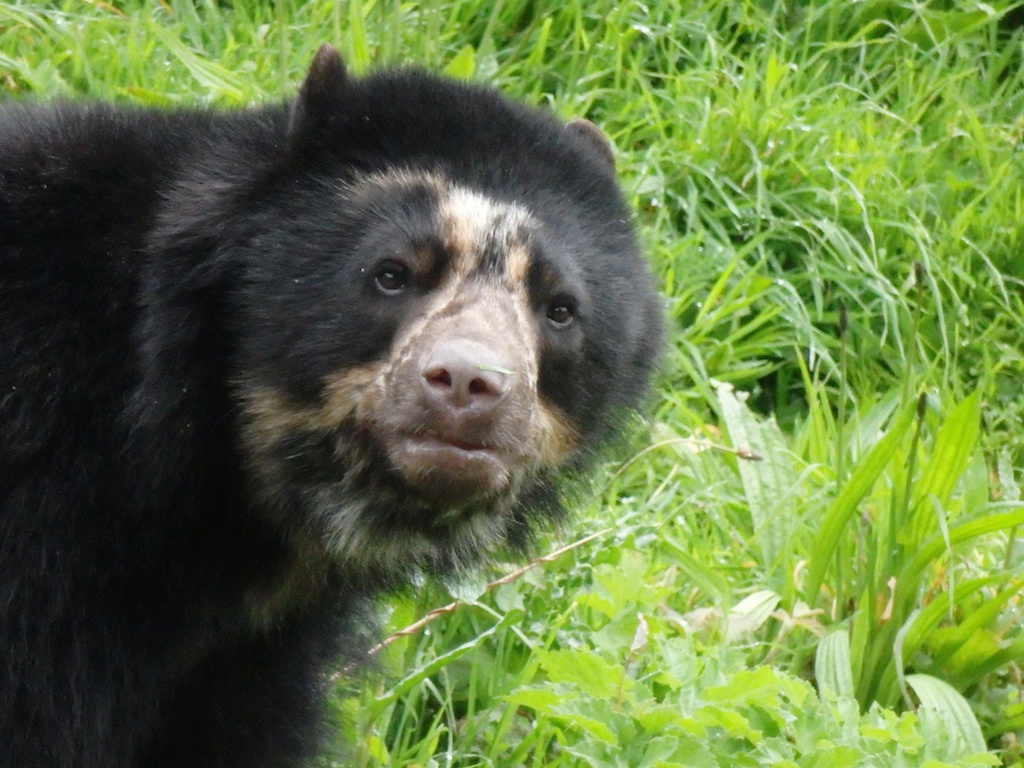 2 Life in sanctuary
2 Life in sanctuary
The Andean bears Bahia and Quechua (alias Chui, right) are both 3 years old, she born in December, he in the following January, but they are conspicuously different to look at. They each have spectacle markings, his similar enough to his predecessor, Wolfgang, to be uncanny at first, while hers is a perfect yellow curve above her eyes.
Chui is much bigger, his coat thicker and more luxuriant. Bahia is so much smaller that visitors often think the pair are mother and cub. Her coat is thinner and more patchy, just like her predecessor Barbara’s. It was never quite certain what caused Barbara’s skin condition, various causes were investigated, like allergies, hormonal imbalance, stress, until it was found to be alopecia. This is suffered by twenty six other Andean bears in captivity, not all of them females, but Bahia doesn’t have this condition.
At first, the intention was to separate the bears, as they live in solitary state in the wild. But Bahia was unhappy on her own, and very pleased to see Chui when he arrived. Once the initial inspection from separate quarters was completed and the connecting door opened she became a much happier bear, so at the moment the two of them are staying together. The metal grid between the inner and outer pen is sometimes only left open a fraction, wide enough for Bahia to squeeze through for some privacy if she wants to. But it hasn’t proved to be any hindrance to Chui, any more than it was to Wolfgang, for he too can squeeze his bulk through it when the female on the far side is encouraging enough.
Chui’s quarters may change in the future, they certainly will if the pair breed once they reach sexual maturity when they are about five years old. The inner cubbing den was used several times by Barbara, who I think had five pairs of cubs. But the number of cubs Bahia and Chui may have will depend on how many homes there are for the youngsters in other safe places throughout the world. Most zoos are full to capacity with their species, so it’s often a question of assessing which bears are ageing and likely to die, then which genetic matching among younger bears is most important. Timing is crucially important as well, as the cubs will stay with their mother for two years, possibly three, during which time Chui would be based in another enclosure, and after that the youngsters will need to move out into territories of their own.
Talking to various people here on this visit I fully realised for the first time that creatures like these bears will never go back to their natural homes in the wild – neither they nor their heirs – unless the world changes beyond recognition to provide them with secure lives in their native lands. Their homes will always now be sanctuaries like these – places where they can be kept safe, their gene lines maintained in as natural an environment as possible in case of miracles, and where we and future generations can come to imagine what the wild world was once like before we destroyed it.
3 Chui makes himself comfortable
Quechua or Chui, as the male Andean bear is fondly known, was fast asleep when I saw him again for the first time in 2015. His black bulk filled his shredded-paper-lined nest in the main den, his gold-marked head rested on a thick pillow of hessian sacking. As I watched, he shifted in his sleep, rolling over to dangle both front legs over the edge of the nest frame. Still he slept, his paws twitching from time to time as he dreamed.
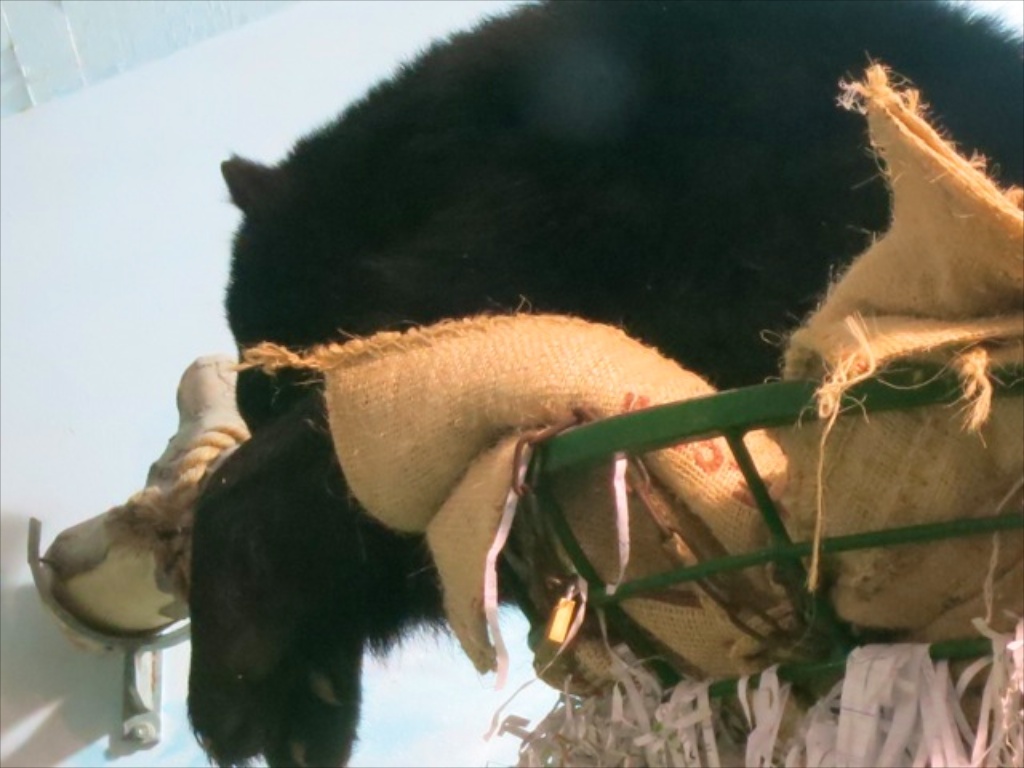
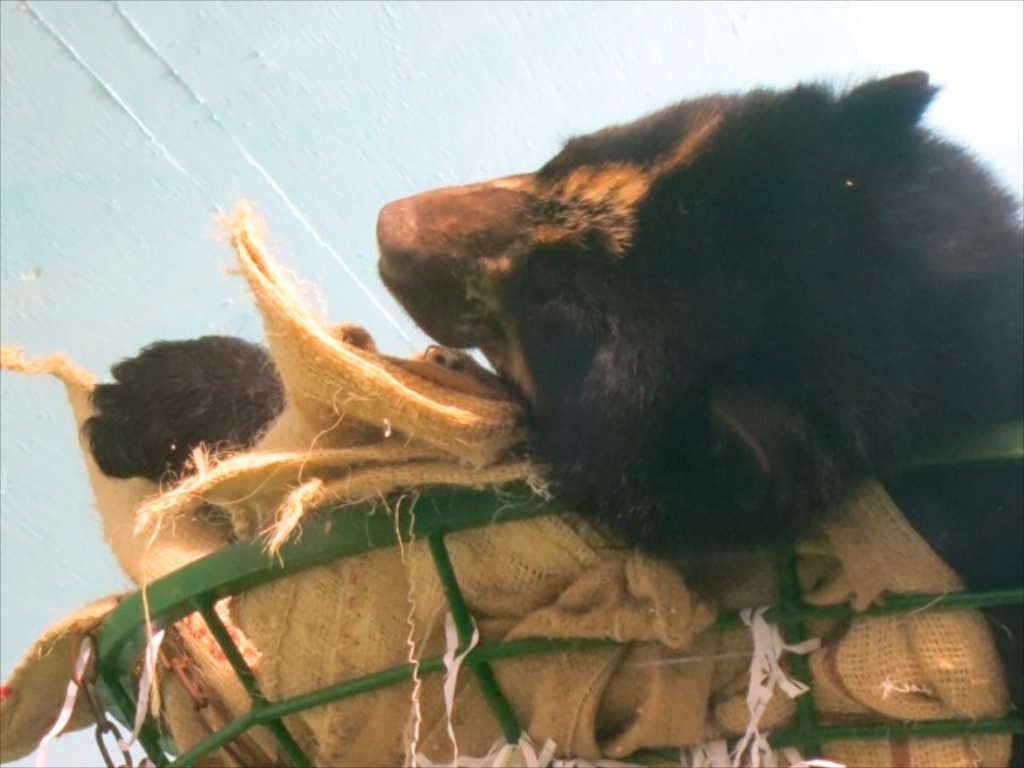
Behind him, Bahia, the female, was almost hidden in the nest she had created on top of the metal door cage. She had dragged the shredded paper from the other nest and taken it up to her preferred spot, where she had spread it out and sprawled across it to sleep.
It was only later that I realised Chui had created his own pillow, pulling a sack from a few that had been hung up in the den. When he was awake and active I saw him investigating these, pushing and pulling at them as they dangled from a big chain. He gave one hefty shove, sending them swinging, before deciding to venture outside for something more exciting – probably food.
13 April 2015
4 The Three Bears
There are now three bears in the First Impressions enclosure, Bahia, the female, Chui, the male, and a young cub. Bahia gave birth to a male cub earlier in the year and can occasionally be seen on the webcam in the inner cubbing den where she and the cub have lived since his birth.
She has a nest of shredded paper there where she sits, pulling the baby to her, playing with him, and cuddling him. When he began to suckle, Bahia lay right back, holding and stroking him as he fed. When he moved from one nipple to the other she licked herself tidily clean after him. As soon as he had fed his full he wandered out of sight of the webcam, with Bahia right behind him.
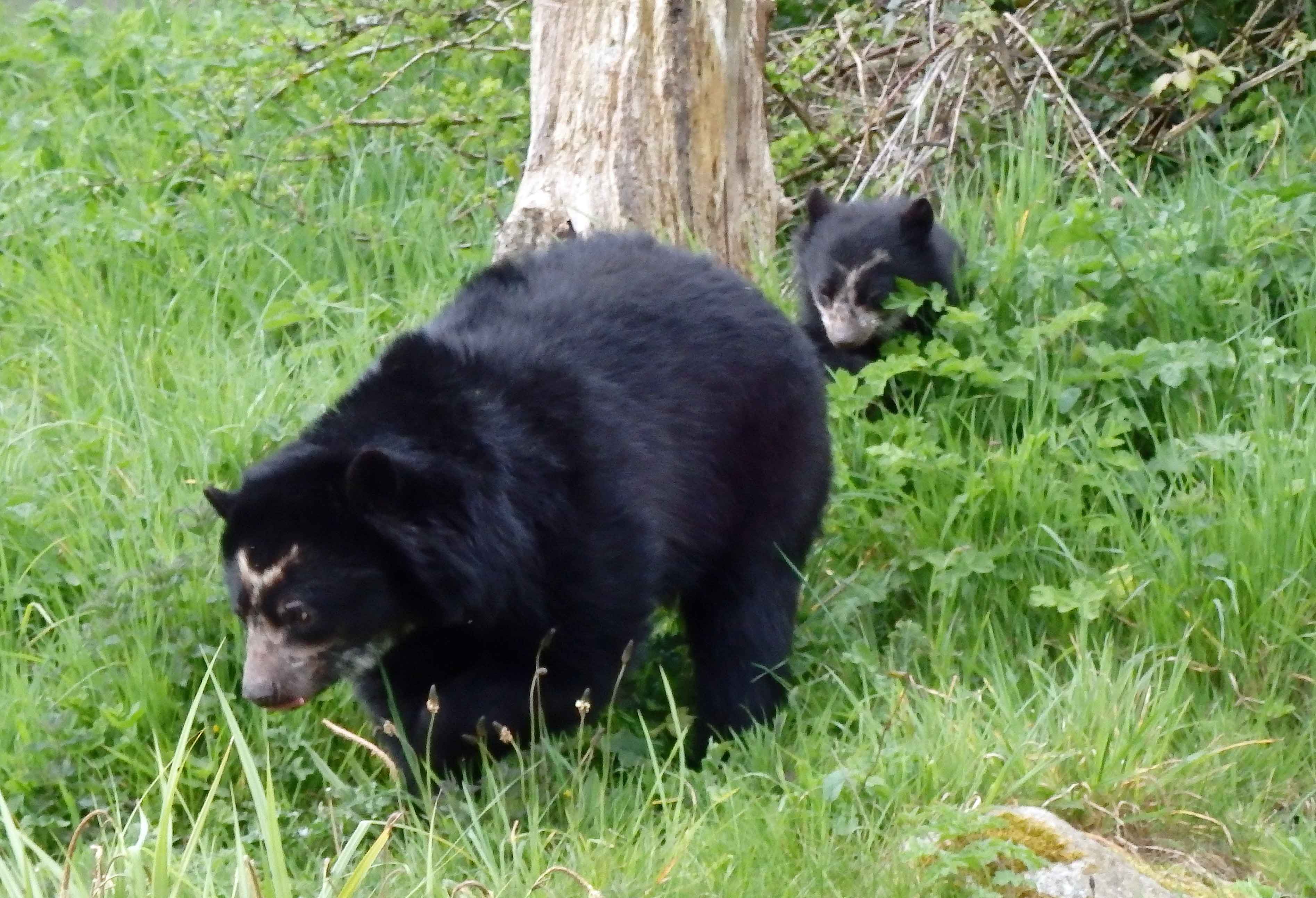
They stay indoors while Chui, the male, is outside. Their time to explore the wider world comes when he has been shut into his side of the bear house. Mother and baby have been venturing outside for a week now, and the water in the moat surrounding the enclosure has been drained to a shallow slick to prevent accidents when the cub goes exploring.
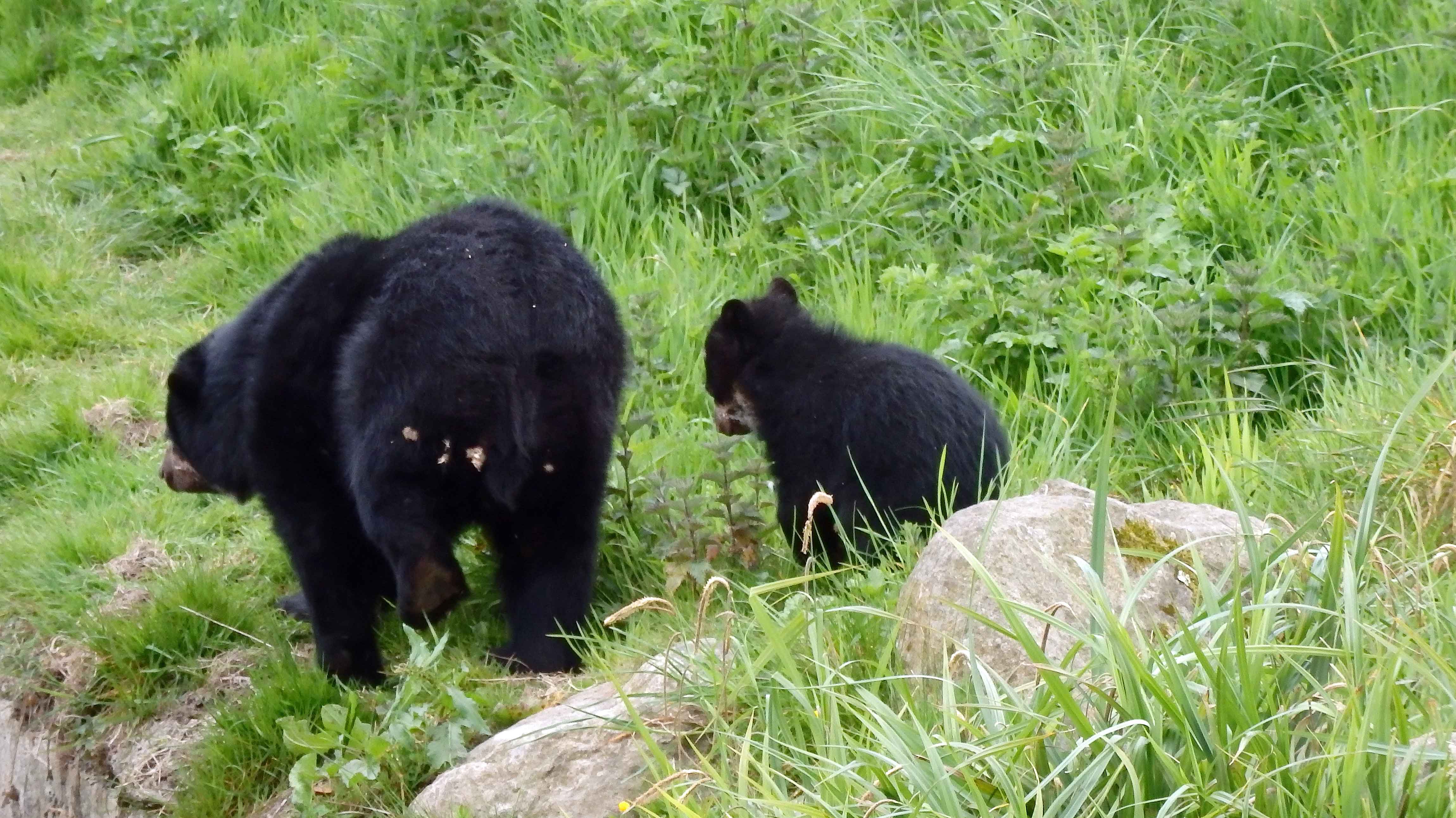
Both Bahia and the baby have faded colouring, as they need sunlight to turn their markings from grey to gold. The baby’s markings are a mirror image, if a faint one at the moment, of his father’s. Bahia didn’t eat for two months after the birth. She survived and fed the baby on her fat reserves, so she was very thin when she emerged.
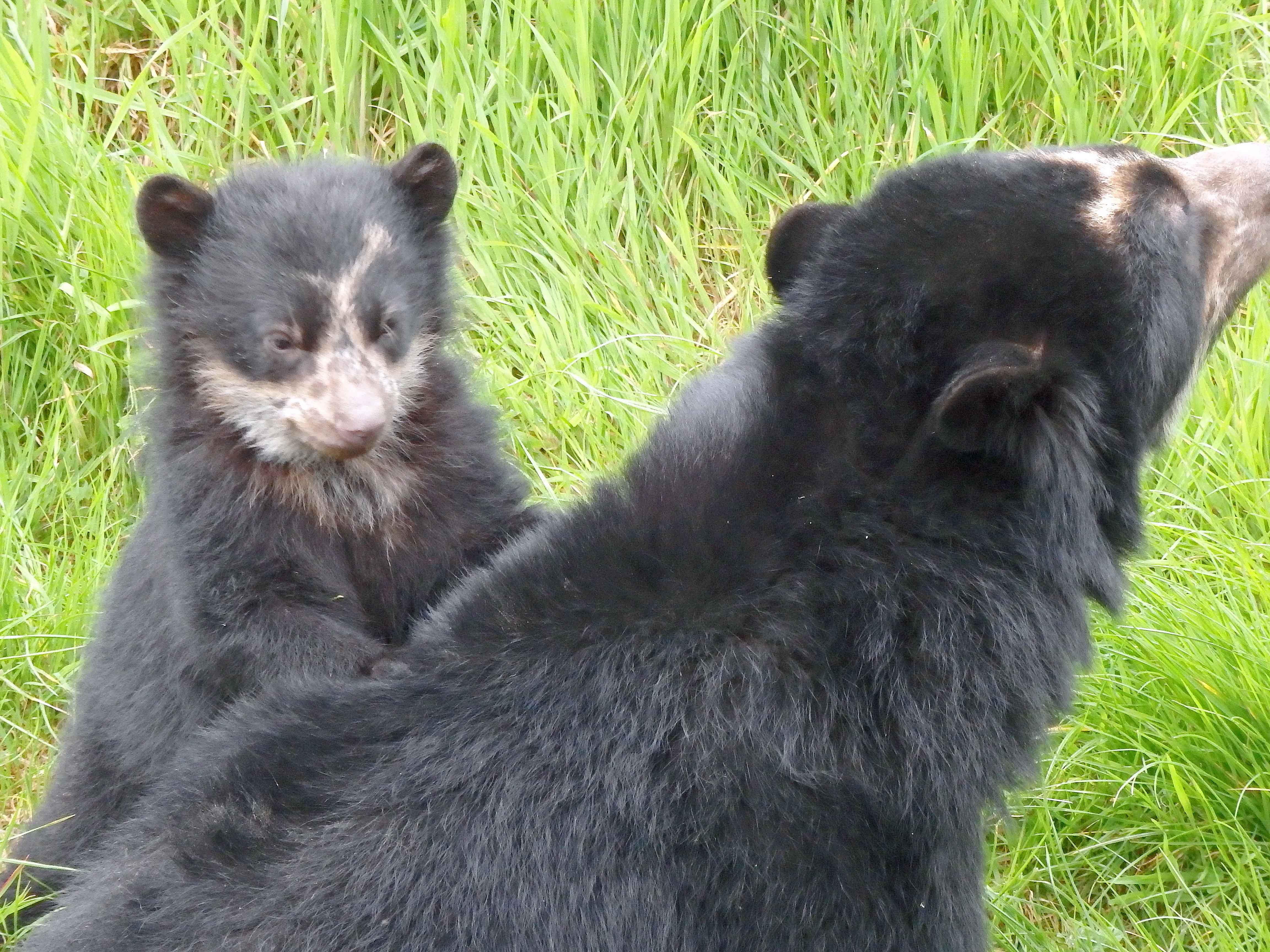
Chui is living a solitary existence, separated from mother and cub, and only coming outside briefly. He perched on one of the trunks and split a piece of wood, presumably to find something tasty that had been inserted into it. When he was back indoors he went to the caged door, where the keeper let him lick a stick through the mesh. This had been dipped in honey and peanut butter, and once he’d got the taste of this the stick was put on top of the cage to encourage him to climb up it. He’s being encouraged to exercise, as the horde of bouncy balls around the floor testified. He’s being kept occupied as well as possible, as he’s very glum. He misses Bahia.
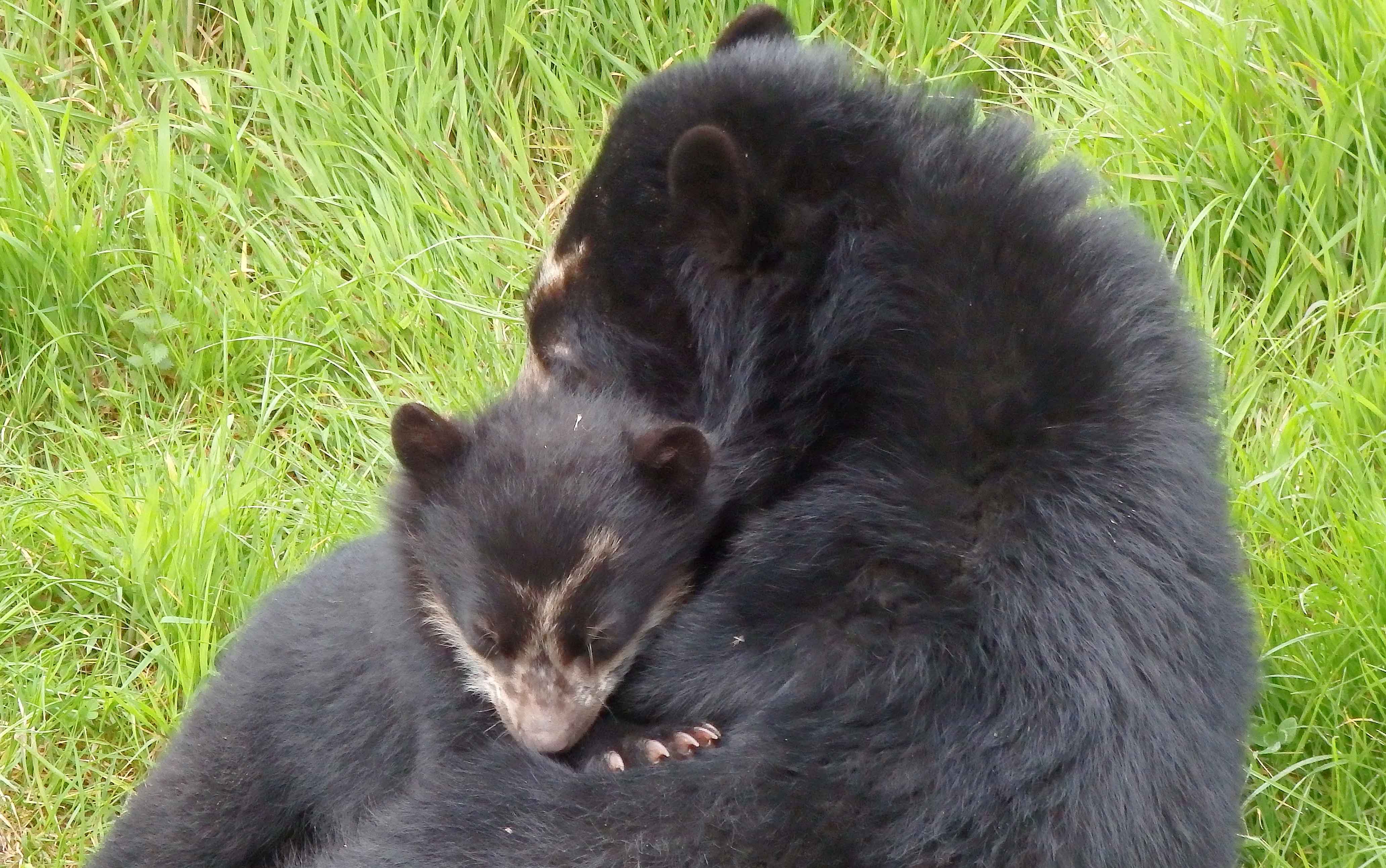
And Chui’s not very interested in all the artificial fun and games. But he does express himself vigorously when his frustration become too much. He slams the balls across the floor, so that they ricochet off the walls, before stalking outside for a short time. When he jumps up and down repeatedly on the scales and claws at the caged door he may be demanding attention from the keeper. Or he could still be frustrated, especially if he could hear mother and baby running up and down their quarters, Bahia playfully chasing the cub.
The cub is very adventurous, good at climbing up obstacles, although not so good at descending. But he seems to fall well, without harming himself. Bahia is unconcerned by his acrobatics, but she did see off a large gull when it came too close.
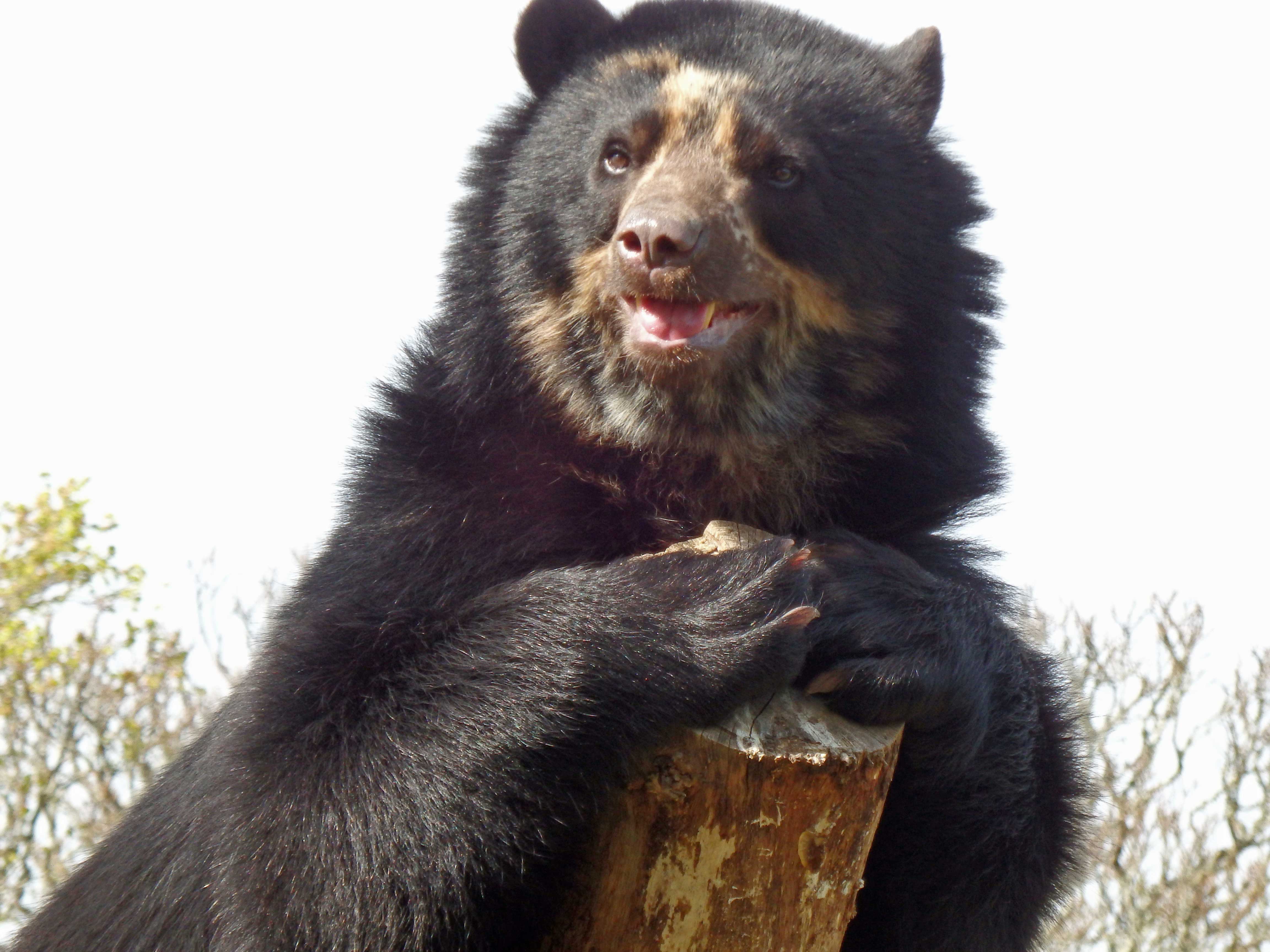
Chui has been allowed around the back to have eye contact with mother and son, and the dynamics between him and Bahia seem good. It’s hoped that the family can be reunited soon. But at the moment he can’t be outside, even in a separate area, when Bahia and the cub are out, in case he pushes down the fence to get to them. The cub will stay with Bahia until he’s sexually mature, at about 2 years old. When he leaves, Bahia will come into season again.
Back to top24 April 2016
5 Teaching baby
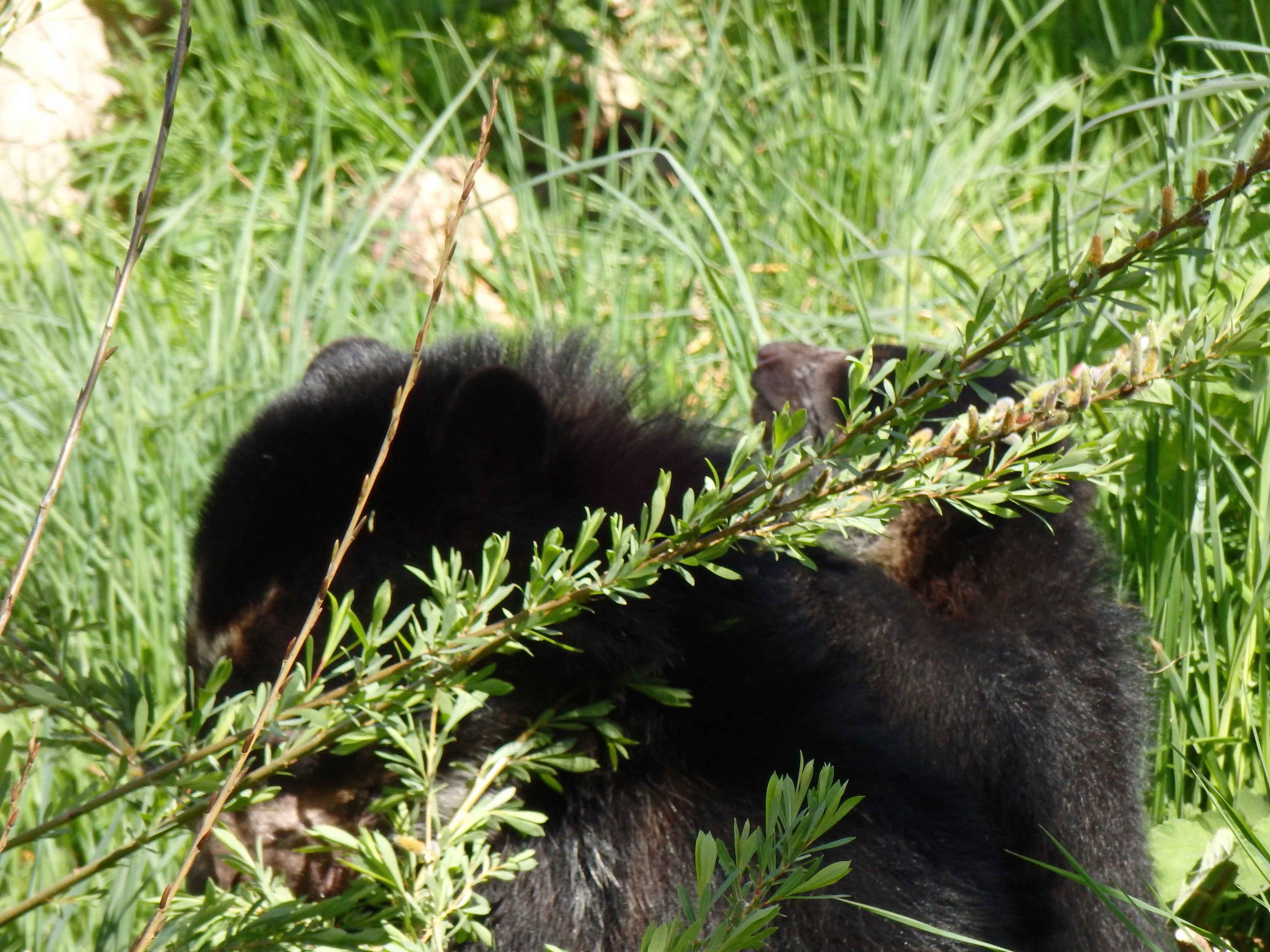
On the bears’ webcam I could see Bahia sifting new shredded paper bedding. Baby wrestled half a loaf of bread from her and played with it, tearing pieces off. Soon he began to draw the shredded paper together, imitating his mother, turning in it to make it a hollowed nest. He stopped in his task to lay back and play with a handful of the paper, before curling up for a nap.
When Bahia left the den, the baby rolled over to watch and lay stretched out over the edge of the nest, where he soon fell asleep again.
Bahia came back in later and tried to wake the baby to take him outside. Baby was sound asleep and limp, so she dragged him away by the scruff of his neck and tried to nudge him onto his feet. Baby stirred briefly, but went straight back to sleep so Bahia covered him with paper and lay down beside him.
By tea time, the roles had been reversed. Bahia was asleep and the baby was lively, darting out of the cubbing den and reappearing, bouncing like an excited puppy, with a stick to lick.
Baby is imitating his mother and exploring his world, both indoors and out. Soap suds from the floor washing in the neighbouring coatis’ enclosure fascinated him as they crept closer and closer.
But he wasn’t so sure of the water spurting out of the hosepipe, and backed away quickly when the jet was turned towards him.
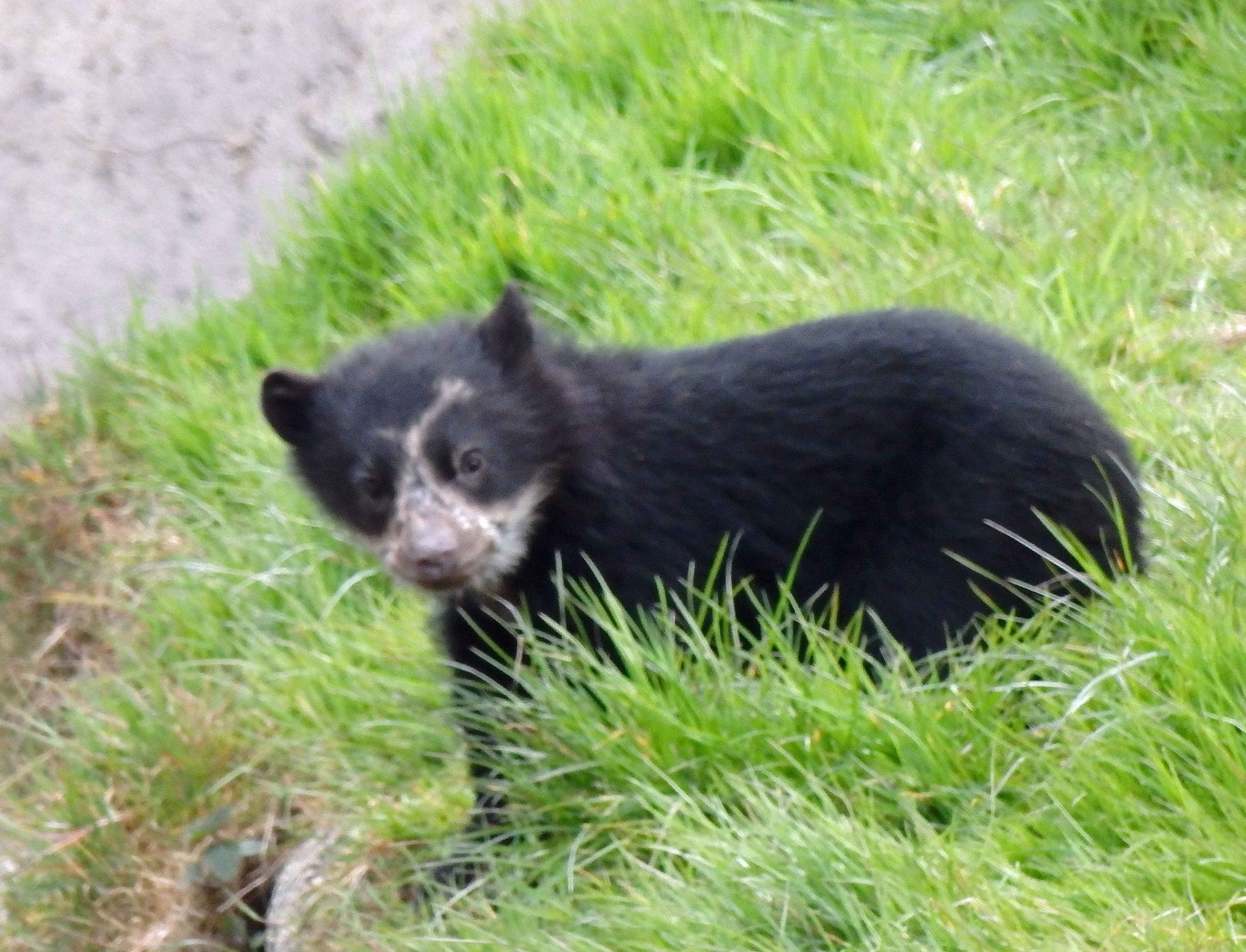
Bahia goes outside before she encourages the baby to come out too. She grazes a bit, making the most of some personal time, checks the fruit bowl, then checks too that the electric guard on the trees has been removed.
When she goes back to fetch the baby, he usually has to be roused from sleep and persuaded to go with her. He’s often a little unsteady and bleary-eyed when he’s first woken, and follows his mother closely in this big wide outdoor world. He leaps over clumps of grass, pushing through the taller stands of grass with just his ears visible, jumping down a steep drop to land in thick grass and vanish momentarily from sight. He tried a couple of times to climb onto Bahia’s back to make progress easier and was pushed off to make his own way.
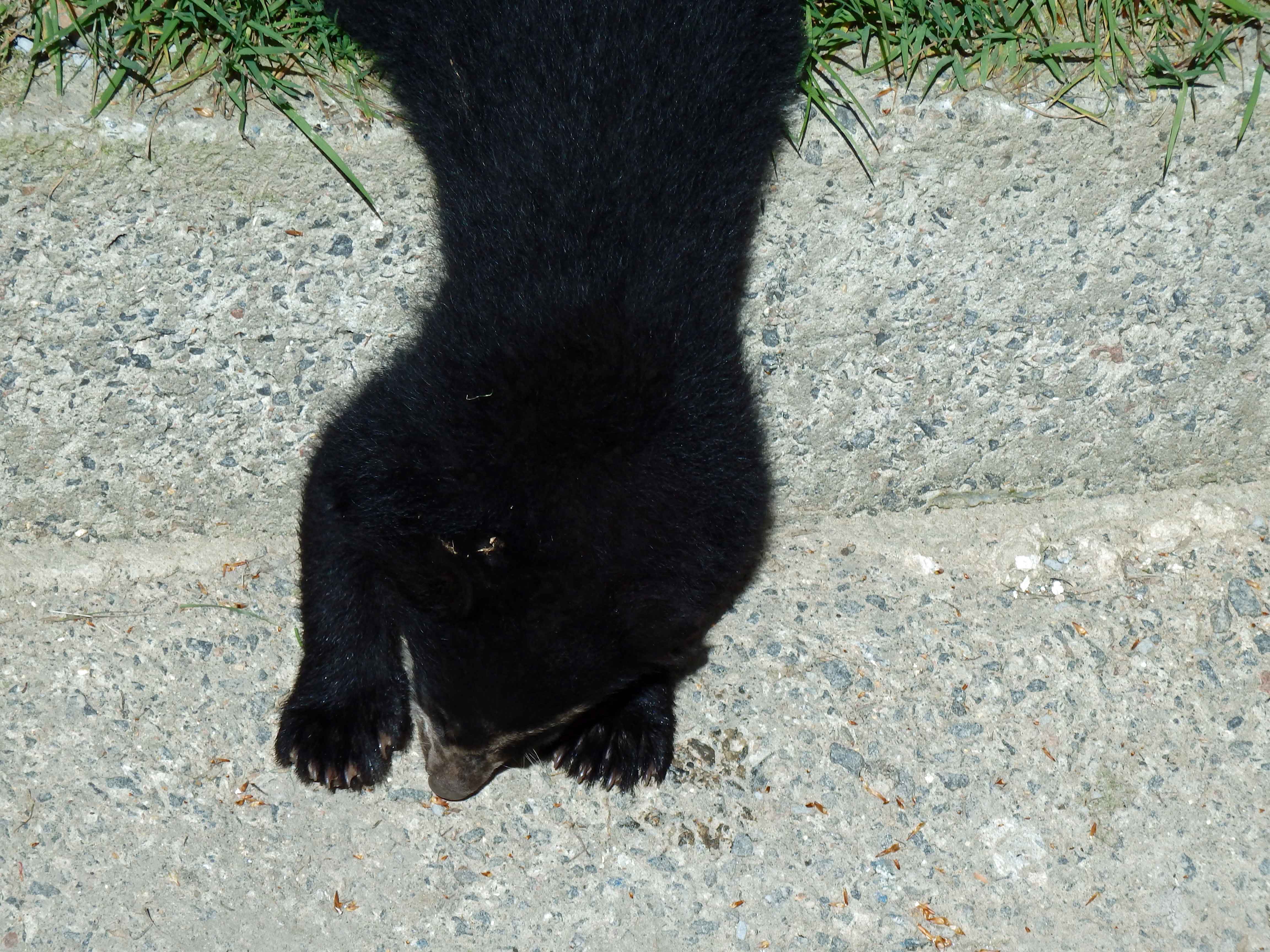
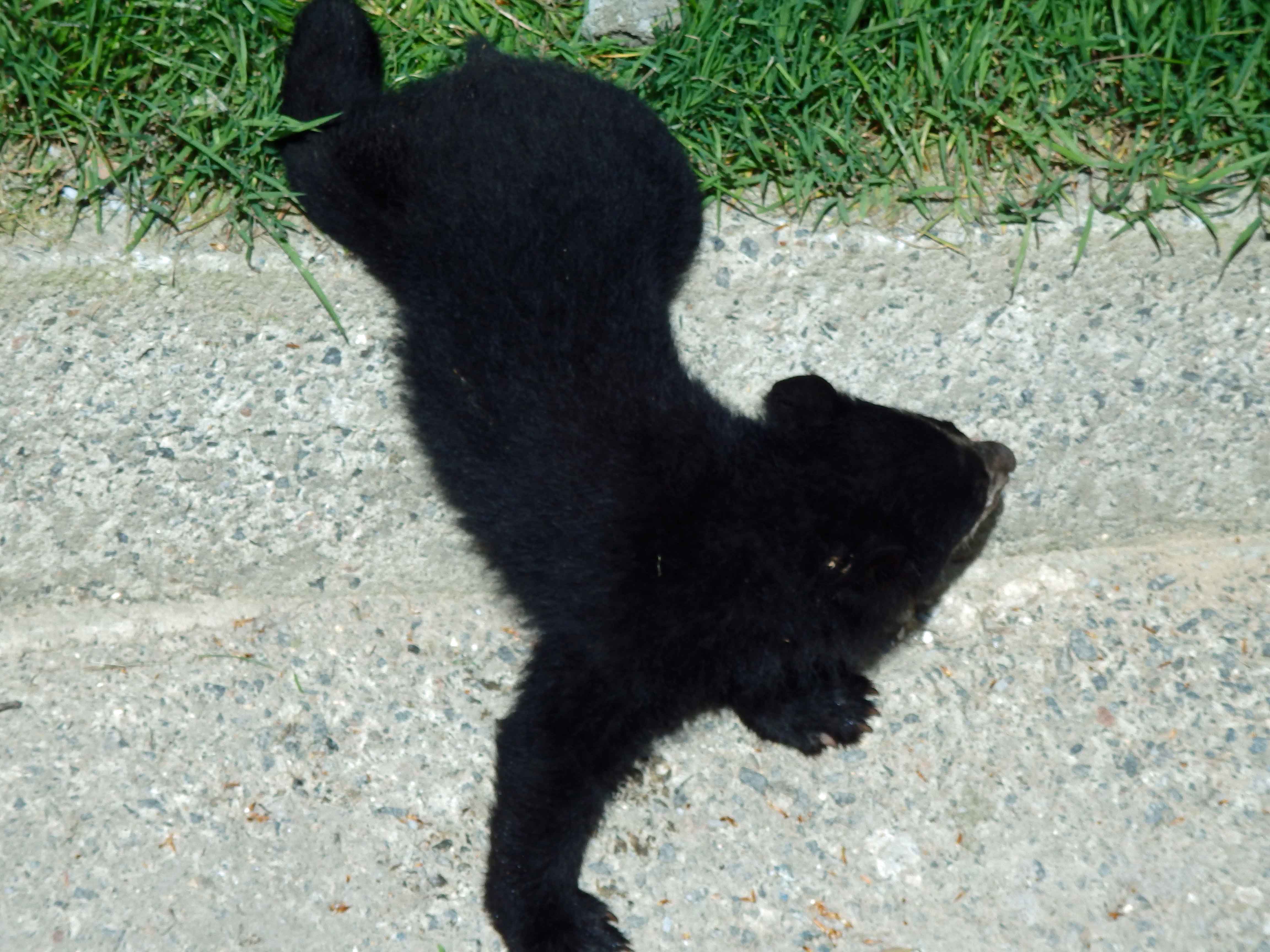
Then began a cautious exploration of the moat, as he ventured after Bahia who had gone down into the shallow trickle of water. He negotiated the concrete rim with care – one back paw was still at the top when he was at full stretch with both front paws down on the concrete slope.
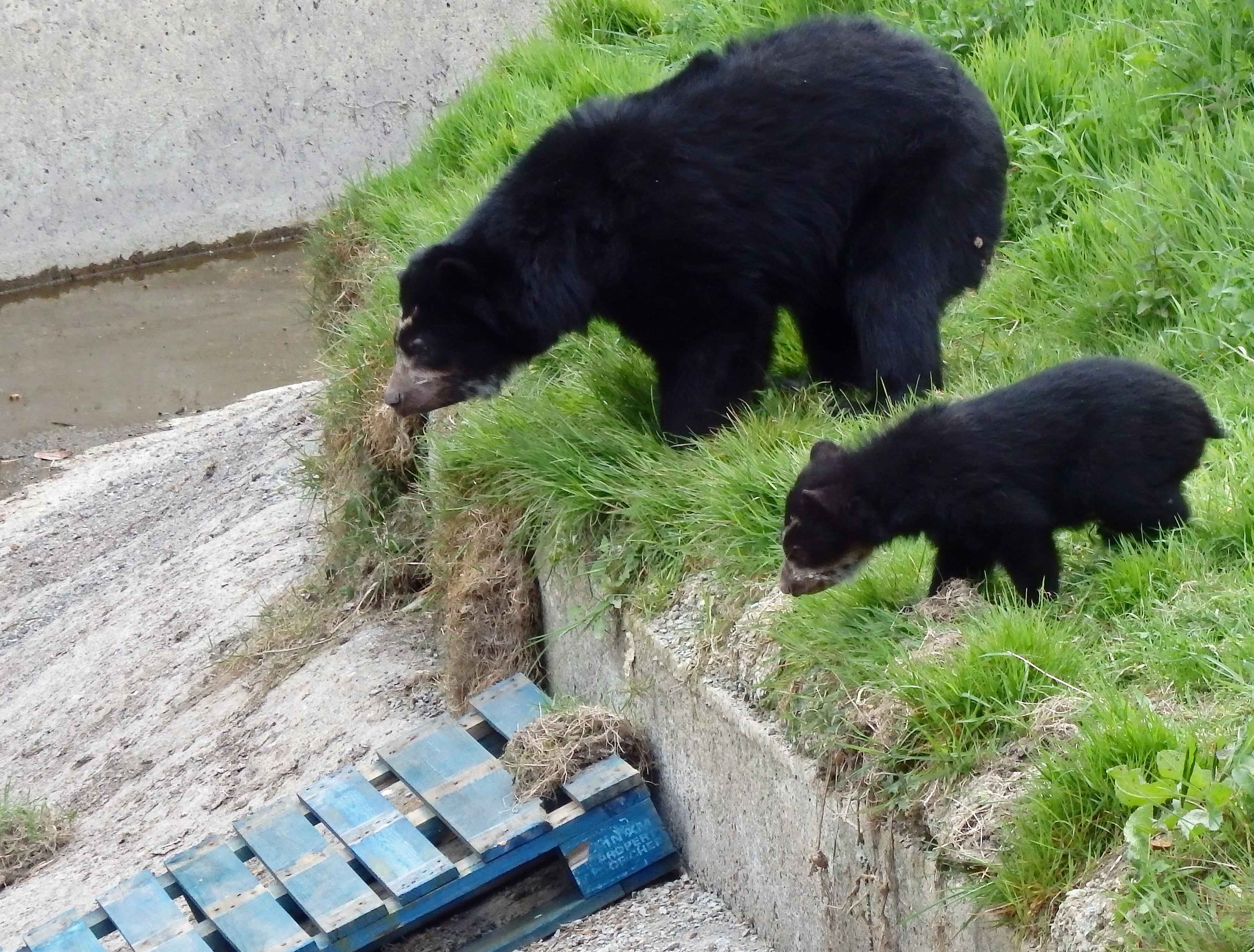
Both were startled when Bahia inadvertently moved the nearby wooden pallet, which had been put in to help the baby get up and down here. But Bahia helped him on his chosen way, her nose under his tummy, one paw under his bum, gently lifting him down.
Later on, they came down again by the bridge, where the baby put his paws in the water and sipped, before retreating, following Bahia up a pallet.
When Bahia had had enough of outdoor activity she picked the baby up by the scruff of his neck and carried him back to the den, dangling lengthwise from her mouth. It was time for a feed.
Bahia likes grapes, fed by hand through the wire of the door enclosure. Then come peanuts in shells, which the baby fancied too. He only has tiny scraps as he’s just started on solids – mango and banana. He climbed up the door cage, as Bahia did, to forage in the straw above. The baby now seems to have got the idea about going down backwards from this height. He waved one back paw over the edge, but didn’t quite have the courage to risk the move, so Bahia carried him down.
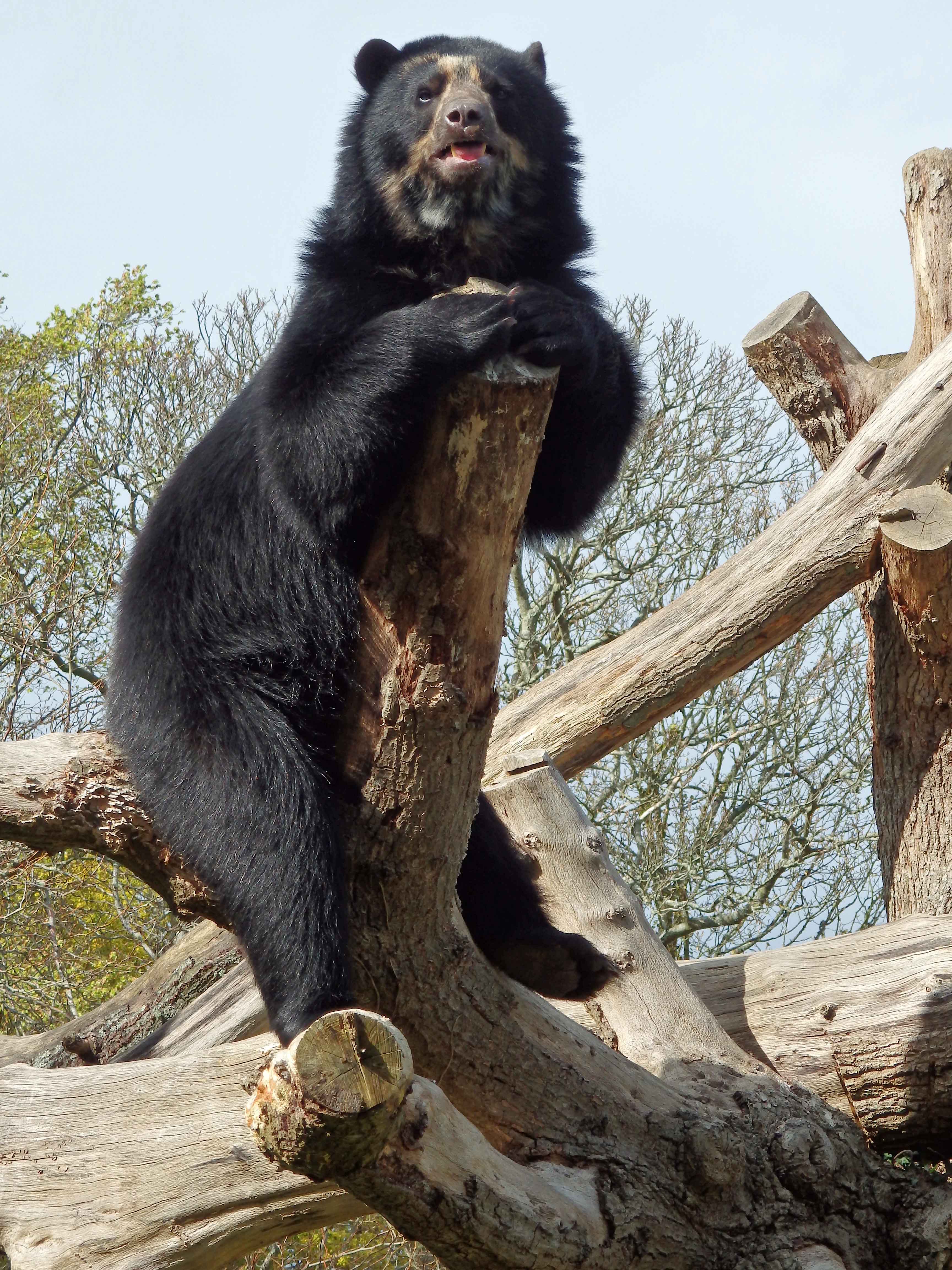
Chui is often seen bouncing up and down, indoors and out, sometimes in one of the trees. Occasionally he suns himself, sprawled full length along the one of the wooden tree trunks by the moat, sniffing at food smells from the distant café. He too likes peanuts, and is enticed in with them, coming right up against the door cage of the main indoor enclosure, and so standing on the scales. He weighed in at 119 kg, and soon began to jump up and down, waiting for his evening fruit snack. He has this outside, but took his time to follow the keeper. As food rained down around him in the enclosure, he ignored it, pulling half a loaf of bread out of the undergrowth and settling down to eat that, while a seagull began to eat the fruit.
25 April 2016
More from this site
- 2017 Archive
- • January 2017
- • February 2017
- • March 2017
- • April 2017
- • May 2017
- • June 2017
- 2016 Archive
- • January 2016
- • February 2016
- • March 2016
- • April 2016
- • May 2016
- • June 2016
- • July 2016
- • August 2016
- • September 2016
- • October 2016
- • November 2016
- • December 2016
- 2015 Archive
- • January 2015
- • February 2015
- • March 2015
- • April 2015
- • May 2015
- • June 2015
- • July 2015
- • August 2015
- • September 2015
- • October 2015
- • November 2015
- • December 2015
- 2014 Archive
- • January 2014
- • February 2014
- • March 2014
- • April 2014
- • May 2014
- • June 2014
- • July 2014
- • August 2014
- • September 2014
- • October 2014
- • November 2014
- • December 2014
- 2013 Archive
- • January 2013
- • February 2013
- • March 2013
- • April 2013
- • May 2013
- • June 2013
- • July 2013
- • August 2013
- • September 2013
- • October 2013
- • November 2013
- • December 2013
- 2012 Archive
- • January 2012
- • February 2012
- • March 2012
- • April 2012
- • May 2012
- • June 2012
- • July 2012
- • August 2012
- • September 2012
- • October 2012
- • November 2012
- • December 2012
Extracts from the novels
Submit your comments
If you have any comments, please send them in. They may be published on the site.